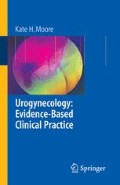Conclusions
Urodynamic testing requires careful attention to detail, both in the selection and counseling of the patient during the test, in performance of the provocation maneuvers, and in analysis of the results, to obtain precise diagnoses of the components of the continence disorder. Unlike an ECG that can be performed by a technician, this test requires a trained clinician in order to yield the maximum information.
Access this chapter
Tax calculation will be finalised at checkout
Purchases are for personal use only
Preview
Unable to display preview. Download preview PDF.
References
Abrams P (1997) Urodynamics, 2nd edn. Springer, London.
Abrams P, Cardozo L, Fall M, Griffiths D, Rosier P, Ulmsten U, et al (2002) The standardisation of terminology of lower urinary tract function: Report from the Standardisation Sub-committee of the International Continence Society. Neurourol Urodyn 21:167–178.
Adekanmi OA, Bombieri L, Freeman RM (2001) Occult incontinence: A review. Aust Continence J 7:40–43.
Cardozo L (1997) Urethral problems. In: Urogynaecology. Churchill Livingstone, New York, Chapter 24, pp 377–386.
Cardozo L, Staskin D, eds (2001) Textbook of female urology and urogynaecology, Martin Dunitz, London, Chapters 17–27, pp 183–312.
Haylen BT, Ashby D, Sutherst JR et al (1989) Maximum and average urine flow rates in normal male and female populations—the Liverpool nomograms. Br J Urol 64:30–38.
Herschorn S (2001) Videourodynamics. In: Cardozo L and Staskin D (eds), Textbook of Female Urology and Urogynaecology. Martin Dunitz, London, Chapter 24, pp 264–274.
Hilton P (2001) Surgical fistulae and obstetric fistulae. In: Cardozo L and Staskin D (eds), Textbook of Female Urology and Urogynaecology. Martin Dunitz, London, Chapters 55, 56, pp 691–720.
Jarvis GJ (1982) The management of urinary incontinence due to primary vesical sensory urgency by bladder drill. Br J Urol 54:374–376.
Jung SY, Chancellor MB (2001) Neurological disorders. In: Cardozo L and Staskin D (eds), Textbook of female urology and urogynaecology. Martin Dunitz, London, Chapter 65, pp 837–853.
Karram MM (1999) What is the optimal anti-incontinence procedure in women with advanced prolapse and “potential” stress incontinence? Int Urogynaecol J 10:1–2.
Nichols DH, Randall CL (1996) Urethral diverticulum and fistulae. In: Vaginal surgery, 4th edn. Williams and Wilkins, Baltimore, Chapter 18, pp 422–425.
Resnick NM, Yalla SV (1987) Detrusor hyperactivity with impaired contractile function: An urecognized but common cause of incontinence in elderly patients. JAMA 257:3076–3081.
Rights and permissions
Copyright information
© 2006 Springer-Verlag London Limited
About this chapter
Cite this chapter
(2006). How to Conduct Urodynamic Studies: Essentials of a Good Urodynamic Report. In: Urogynecology: Evidence-Based Clinical Practice. Springer, London. https://doi.org/10.1007/1-84628-165-2_4
Download citation
DOI: https://doi.org/10.1007/1-84628-165-2_4
Publisher Name: Springer, London
Print ISBN: 978-1-84628-164-8
Online ISBN: 978-1-84628-165-5
eBook Packages: MedicineMedicine (R0)

